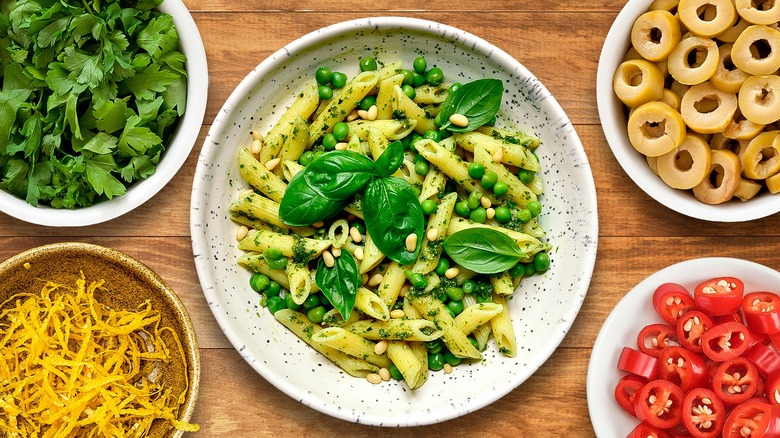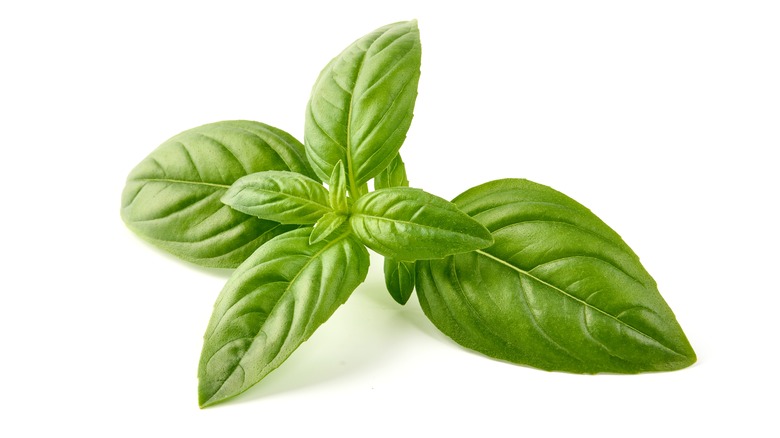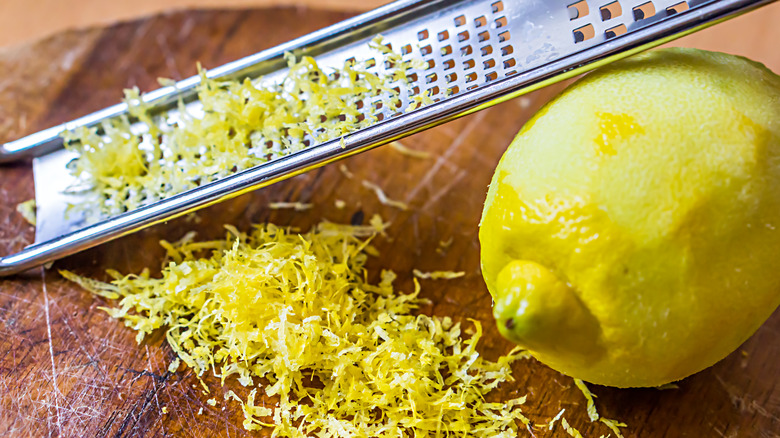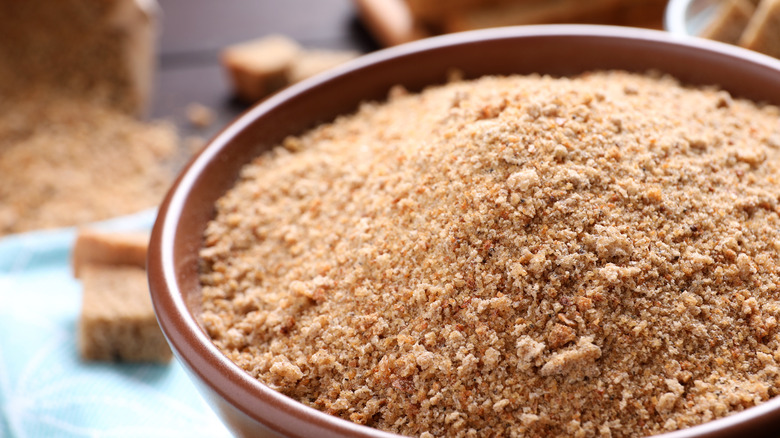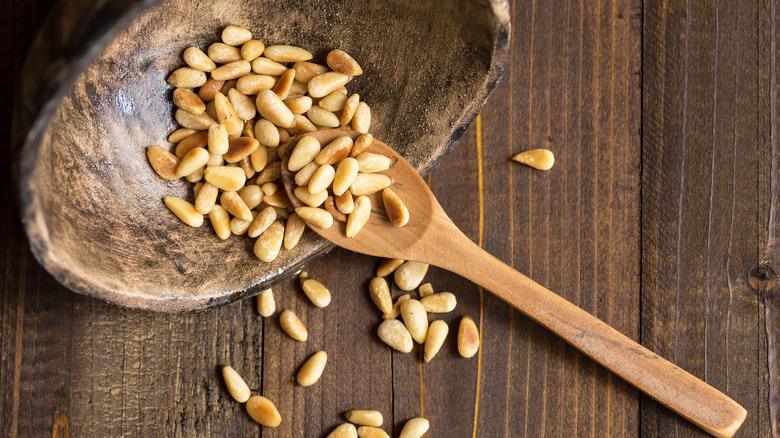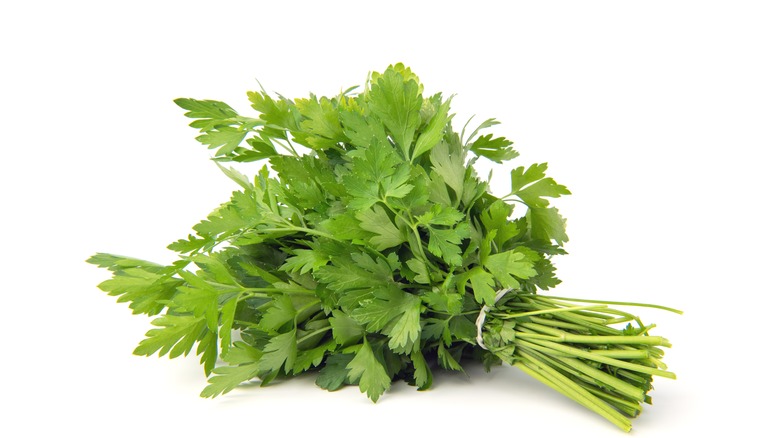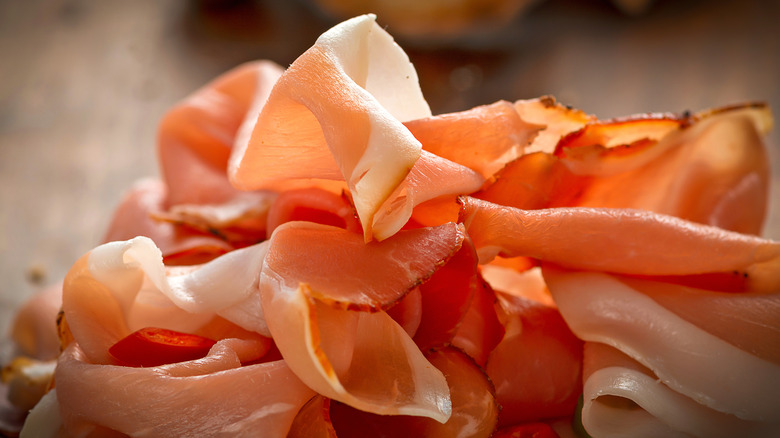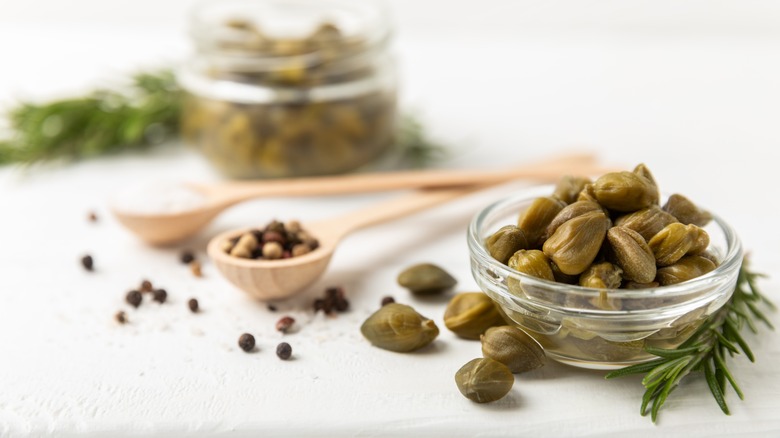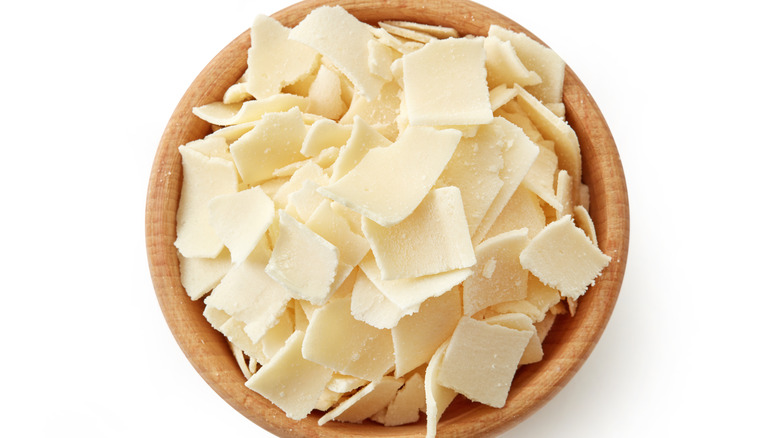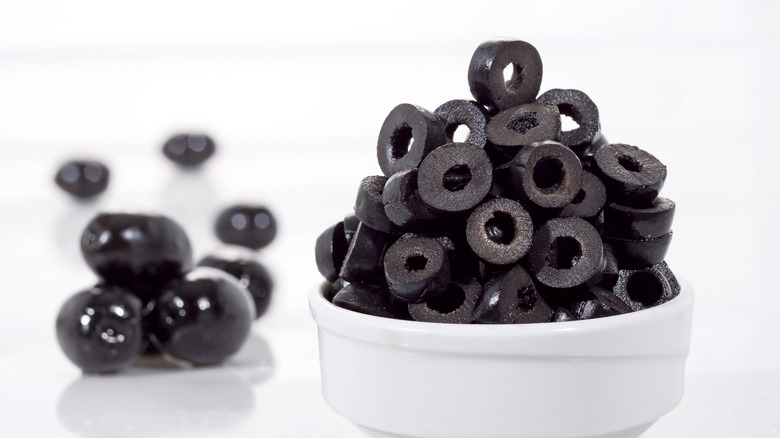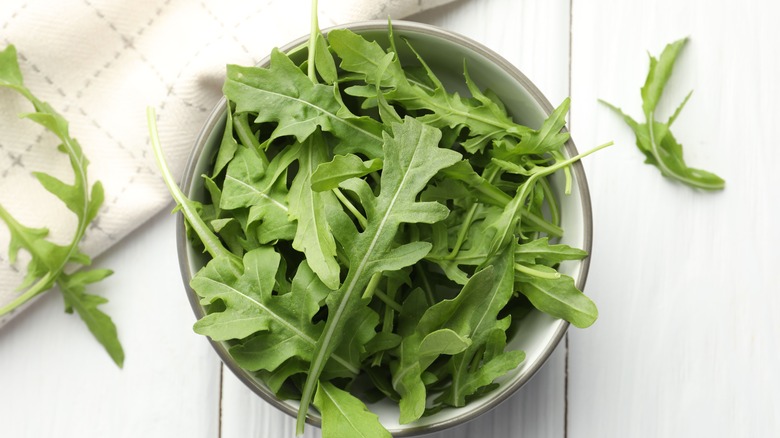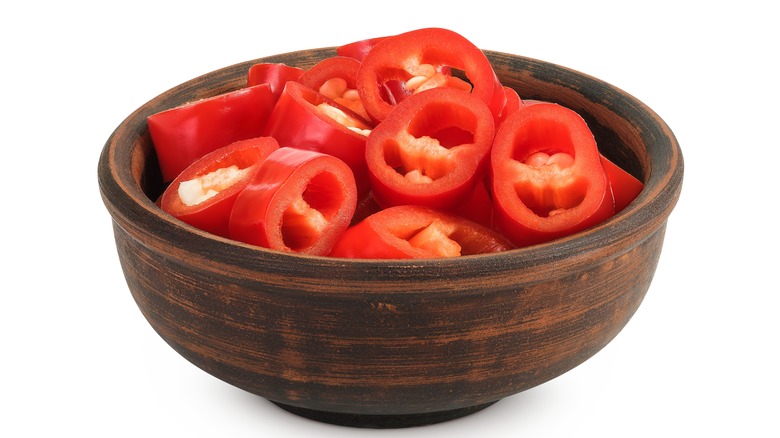11 Fresh Garnishes You Should Be Adding To Pasta
Pasta is a brilliant option for a midweek meal as it's easy to prepare, loved by the whole family, and endlessly customizable to keep fussy eaters happy. It's easy, though, to get into a bit of a rut with something as simple as pasta, and find yourself serving exactly the same bowl of food every time. While creating a new sauce is an option, it takes time to perfect, which is something that most of us don't have during a busy weekday.
An easy way to refresh your pasta dishes with virtually no effort is to add different garnish each time. Whether it's a scattering of fresh herbs for flavor and color, or toasted breadcrumbs as a textural component, each topping will alter the dish in its own way, and bring a new twist to an otherwise familiar meal.
To help you decide what to place atop your pasta dish, I asked Italian food blogger Meghan Birnbaum to share her favorite garnishes. From lemon zest to crispy capers, she explains why certain ingredients will work well on your pasta dishes, so that you can level up your midweek meals as soon as possible. So, let's explore the 11 fresh garnishes that your pasta dishes are crying out for.
Fresh basil
When you think of classic Italian herbs, basil is likely one of the first that springs to mind. This intensely aromatic herb is an iconic element of many Italian dishes, including Caprese salad and the zesty basil pesto. Basil also works perfectly on top of pasta, adding a bright note regardless which sauce you are using.
"I'm a huge fan of fresh basil," says Meghan Birnbaum. "Basil brings a bright, herby freshness that works with pretty much any pasta." Tomatoes and basil are a well-known super-pairing, and the thought of having tomatoes in Italy without basil being nearby just seems wrong. If your pasta has a tomato-based sauce, you should definitely be adding some of this vibrant herb into the sauce, but using it at the end as a garnish is also recommended.
Tender herbs such as basil lose flavor the more they are heated, so adding fresh leaves at the beginning of your cooking won't deliver enough aromatics. Instead, tear some leaves — since chopping causes the basil to bruise — and add them during the last few minutes of cooking, to ensure they hold on to as much essential oil as possible. Finish with a generous sprinkle of fresh basil on top to make sure the first mouthful of your appetizing pasta dish is filled with the sweet herbaceous flavor.
Lemon zest
Though Italian cuisine is known for its vibrant flavors and fresh produce, the Italians are also experts at pairing pasta with creamy sauces and still somehow making the combinations taste light instead of cloying and stodgy. One of the tricks to achieving this is to use bright ingredients and garnishes. Meghan Birnbaum recommends using lemon zest as a pasta garnish, noting that it "adds a nice zing, especially with creamy sauces." The great thing about lemon zest is that it adds concentrated lemon flavor to the dish without incorporating the harsh acidity of lemon juice. While the juice is great for the pasta sauce, squeezing it over the top of the dish would likely be too sharp, possibly overpowering the whole thing. Instead, lemon zest, as long as you are careful not to include the white pith below the outer layer, will give a zingy, bright lemon flavor without the harsh and robust notes.
Seafood pasta benefits most from lemony garnish. Seafood and lemon are perfect for each other, and any seafood-based pasta will be elevated by the addition of some freshly grated zest. Since an Italian would recoil in horror at the thought of adding Parmesan to seafood pasta, lemon zest is the perfect garnish for these dishes.
Toasted breadcrumbs
One of the main reasons to add garnish to your pasta is to introduce flavor, but texture is just as important. The thing we love about pasta is its soft, silky consistency, but pairing it with an equally smooth sauce may sometimes urge you to crave contrasting textures. Meghan Birnbaum has a great idea for a garnish that adds crisp without altering the flavor. "Toasted breadcrumbs give that perfect crunch to balance the softness of the pasta," she points out.
The great thing about a breadcrumb garnish is that it plays on a pairing that we already know and love — pasta and bread — but incorporates it into the dish. If garlic bread is your preferred pasta accompaniment, and you want to incorporate similar garlicky flavors into the garnish, try frying the bread in garlic oil before blitzing it in the blender.
You can add pretty much anything you want into the breadcrumb mix, including dried herbs or Parmesan cheese, before sprinkling it onto the pasta at the very end of cooking. Make sure not to add them too long before serving, as the sauce could make them soggy, which kind of defeats the purpose.
Toasted pine nuts
If you want to replace breadcrumbs with something fancier, Meghan Birnbaum has a suggestion that will yield a similar textual effect. "I love adding ... toasted pine nuts," she admits. "That bit of crunch really elevates the dish and gives it some contrast." Compared to breadcrumbs, pine nuts are much larger, so they can give you a more satisfying crunch.
Another reason to add toasted pine nuts is the potential health benefit. These tiny nuts, which make the base of the classic basil pesto sauce, are a great source of good fats, minerals, and vitamins. All these beneficial compounds can add a welcomed nutritional element to your pasta.
Make sure to always toast the pine nuts before you add them, but keep in mind that they are renowned for going from perfectly golden to horribly burnt in a matter of seconds. That burnt, bitter flavor is not something you want to add to your pasta. If toasting them on the stove seems too erratic, you can roast them in the oven instead. Keep the temperature low, and take them out when they hit the beautiful golden mark.
Fresh parsley
When adding fresh garnish to pasta, it is important to consider its function. "Freshness is key, and I think it's important that the garnish adds either flavor or texture without overwhelming the dish," advises Meghan Birnbaum. "It should enhance what's already there." Fresh herbs may seem like a decorative garnish, but if you pair the right herb with the appropriate sauce, it can transform the dish.
"Richer dishes, like Alfredo, need something to cut through the creaminess — lemon zest or even a sprinkle of fresh parsley works great," suggests Birnbaum. Though there are two types of parsley, the one you most likely see in the supermarket will be the flat-leaf or Italian parsley, which is best suited for pasta dishes. Due to its refreshing flavor, it is often used as a palate cleanser and can easily brighten up rich sauces. In neutral-colored pasta dishes like carbonara or Alfredo, parsley also adds a vibrant splash of color.
The next time you see parsley on top of your dish, don't just move it to the side and assume it is merely a decor. Trust that the chef has added it for balance, and enjoy the fresh notes it brings to the dish. When garnishing your pasta, you can add a parsley sprig or finely chop it and scatter it over the pasta for an even flavor distribution.
Crispy prosciutto
If you've had Italian prosciutto as part of an antipasto platter, you most likely remember its soft texture and mild flavor. However, crispy prosciutto is a whole other ball game, and if you have never used it as a garnish, you definitely need to start! Just like bacon, when prosciutto is cooked, it becomes crunchy and more salty, making it the ideal topping for smooth, Italian-style pasta sauces.
Crispy prosciutto works with a wide variety of pasta dishes. For straightforward sauces, such as marinara or the simple Neapolitan aglio e olio, it lifts the minimalist flavors and incorporates a much welcomed super-savory element. With richer, more complex sauces, such as Alfredo, it complements the creaminess, delivering similar qualities as pancetta does in a classic carbonara.
To crisp up your prosciutto, either fry it in a skillet until the edges begin to curl, or cook the slices in an oven or an air fryer until you get the crispy texture you're aiming for. Remember to use prosciutto moderately — it is a garnish and should not overpower other ingredients. As Meghan Birnbaum reminds us: "And less is more — you want the garnish to complement, not steal the show."
Fried capers
Besides classic garnishes, such as fresh herbs and breadcrumbs, it sometimes pays to think outside the box and try a topping that will surprise your dinner companions. Meghan Birnbaum suggests fried capers as a cooked version of a classic Italian ingredient that your taste buds will love. "They're crispy, salty, and briny — a great way to add a little punch to a pasta dish without overdoing it."
Capers, when eaten straight from the jar, can have an overpowering briny flavor that may not work as a garnish. But if you rinse them and fry them in a pan, they transform into tiny bites of brilliance, and add both flavor and texture to the tender pasta.
Pasta puttanesca famously uses capers as an ingredient in the sauce, alongside other bold flavors such as olives and anchovies, but fried capers can be used as a fun garnish on virtually any type of pasta sauce. They work well with seafood, or they can give a lift to creamy sauces or even a simple olive oil sauce. Make sure to taste the pasta dish before adding any seasonings, as the salt from the capers may be enough.
Fresh parmesan shavings
Is there a more classic pasta topping than Parmesan cheese? Probably not, but unless you are using freshly grated Parmesan, you are simply not getting the authentic Italian experience. Pre-grated Parmesan that you find on the shelves of the grocery store is very convenient, and it can be handy to keep in the pantry in case you have an emergency cheesy situation, but it is usually incredibly dry and tastes nothing like the real thing.
One of the essential tips when cooking with Parmesan is to use it fresh. The freshly grated version has a wonderful nutty flavor that adds umami to your pasta dishes. It has the ability to transform a sauce in a way that most other cheeses simply can't. While grating Parmesan over the top of pasta is the most common way to enjoy it, peeling thin shavings using a vegetable peeler will give you a totally different experience. Instead of the finely grated Parmesan disappearing into the sauce as soon as it hits the hot pasta, the fine shavings will sit on top of the dish, adding to the visual appeal and allowing you to truly enjoy its complex flavor.
Chopped olives
If you're looking for an add-on that will add briny notes to your pasta, olives are a great option. They are often added to traditional Italian sauces and work well as a garnish. Although there are many varieties available, most people choose olives based on their color. Generally, green olives are picked early in the maturation and tend to be more bitter. Brown or black olives are more mature and tend to have milder flavor, so they can be a better option for those who prefer subtle nuances.
Besides flavor, olives are a great pasta garnish as they are packed with healthy fats, vitamins, minerals, and antioxidants. If the robust olive flavor stops you from snacking on them, pasta is a great way to sneak them in and take advantage of all the amazing health benefits they provide. If you finely chop them and scatter them on top of pasta, the flavor will not be overpowering, but they will add just enough of a briny note to each mouthful to stimulate your palate. Who knows, if you enjoy olives as a garnish, you may find yourself getting used to the flavor, and eventually snack on them like a true Italian.
Arugula
Sometimes a garnish calls for preparation or advance thought, but occasionally, you can find the perfect topping sitting inside your fridge. Meghan Birnbaum encourages creativity, so you can see what works best. "I always tell people to experiment with seasonal ingredients," she advises. "Sometimes, a little fresh herb or zest can really change the whole vibe of a dish."
Arugula is the perfect example of this, as it shows that what we generally think of as salad can make a great addition to your pasta dish. With its strong, peppery taste, it can deliver a lot of character to pasta dishes, particularly those with a mellow, creamy sauce. The vibrant, herbaceous notes give an added dimension to what may otherwise be a heavy plate of food. It will also brighten up the dish with its striking color and make the plate more attractive. Whether topping a neutral-colored combination or an intense tomato sauce, the vibrant green color is always an eye-catching element.
Adding arugula to your pasta is also a great way to incorporate more greens into your diet. Though you won't be adding much, arugula falls into the category of highly nutritive cruciferous vegetables that many consider superfood, so using it as a garnish may be a great first step to attain some of those beneficial attributes.
Sliced chilis
If you feel stuck in a pasta rut, there is no better way to mix things up than with a bit of spice. Whether you're making a creamy carbonara or a tomato-based marinara, adding some chilis to the plate will lift the whole dish and give your taste buds a reason to celebrate. While you can add them in the sauce as it cooks, saving spicy peppers till the end and using them as garnish means your dish will benefit from the bright color and the crunch.
The beauty of the fresh chili garnish is there are many types, with varying levels of spiciness to choose from. For a mild kick of heat that won't have you sweating, jalapeños have a great flavor with a Scoville rating of around 2,500. For a zestier punch, cayenne peppers will test your palate a bit more, as they clock in at around 50,000 units, while the infamous Scotch bonnet peppers are reserved for the brave. If you are using spicy peppers, make sure to remove the seeds and white membranes to lower the heat slightly, especially if you plan to serve the dish to other people. If you're having guests, perhaps it's best to let them decide on the amount they want to use.
